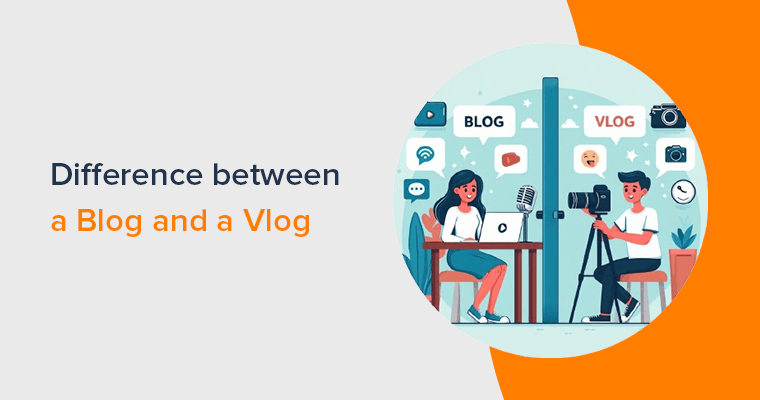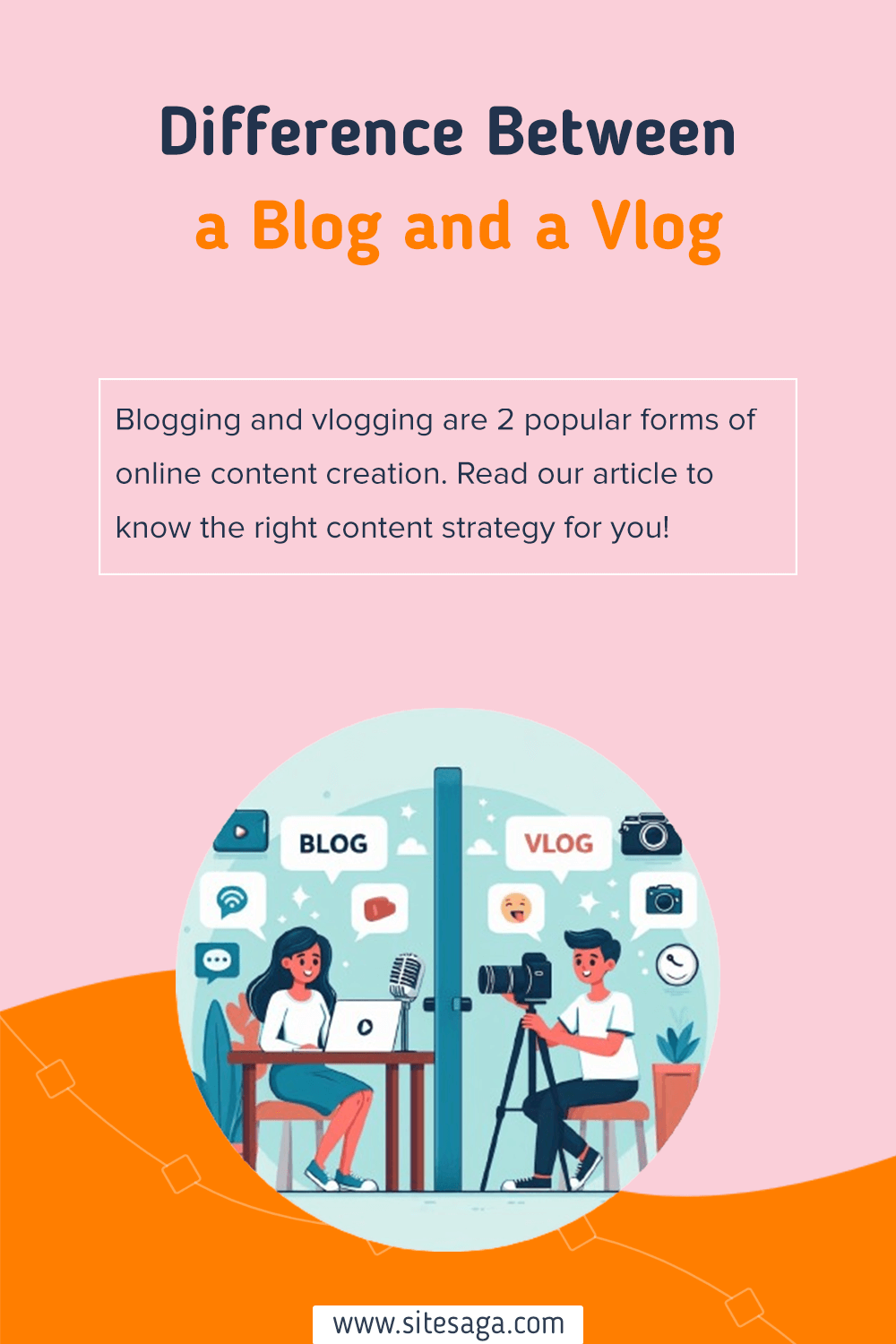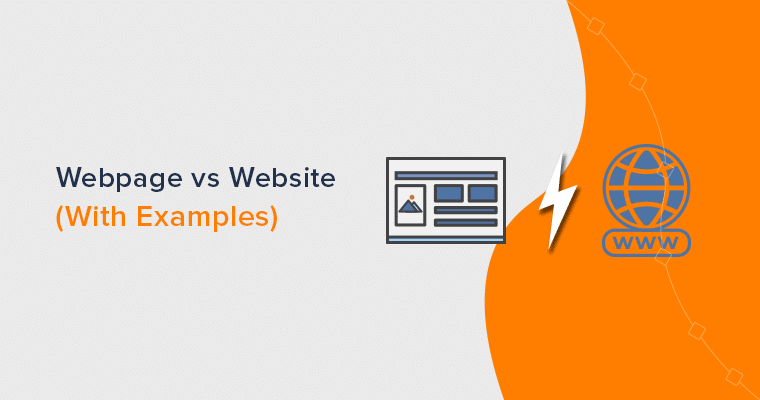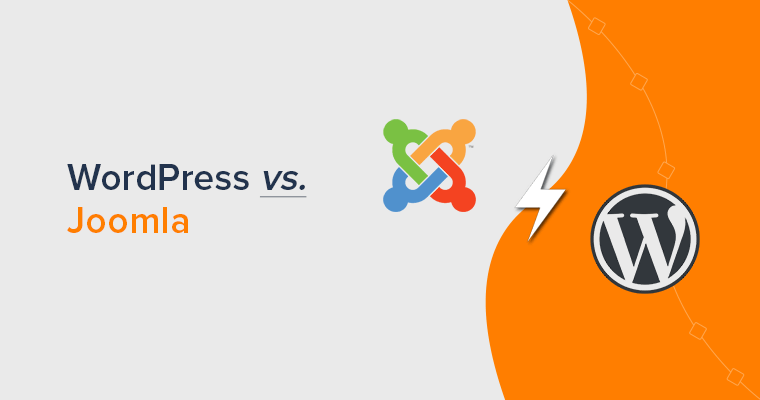Want to know what is the difference between a blog and a vlog? Or wondering which one to choose for your new content strategy? If yes, then stay right here.
Blogging and vlogging are 2 popular forms of online content creation that have emerged in the past two decades. With either of them, you can share your stories, opinions, insights, and expertise with your target audience.
However, there are some significant differences in the medium of expression, content creation, monetization opportunities, etc.
In this article, we’ll explore it all, along with similarities, and guidance to make the right fit, or even combine both for optimal results.
Now, let’s dig in!
A) Quick Comparison Table Between a Blog and a Vlog
Are you short of time? Here, we’ve got you a quick comparison table showing the difference between a blog and a vlog along with the similarities.
| Basis of Comparison | Blog | Vlog |
| Medium of Expression | A website that publishes written articles regularly. | A website or a platform that publishes video content regularly. |
| Type of Content | Mainly consists of texts and images, but can include other formats like audio and video. | Mainly consists of video and audio, but can also include texts and images. |
| Purpose of Content | Allows writers to express their thoughts, opinions, insights, and expertise on any topic. | Allows video creators to document their life experiences, thoughts, and skills on any topic. |
| Skills & Equipment Required | Requires good writing skills, SEO (Search Engine Optimization) knowledge, and web design skills. | Requires good presentation skills, content writing, video editing skills, and camera equipment. |
| Hosting Platforms | Hosted on various platforms like WordPress, Webflow, Wix, etc. | Hosted on various platforms like YouTube, TikTok, Vimeo, etc. or your own website. |
| Monetization Methods | Monetized through various methods like ads, sponsored posts, affiliate marketing, etc. | Monetized through various methods like ads, sponsored videos, merchandise, etc. |
| Audience Preferences | Can attract and retain readers who prefer to consume information through text. | Can attract and retain viewers who prefer to consume information through video. |
B) Video Tutorial – Difference Between a Blog and a Vlog
Do you prefer watching a video tutorial for learning this? Here we go!
Meanwhile, continue reading through to the bottom if you still adore the comprehensive article to explore the difference between a blog and a vlog in detail.
C) Understanding Blogs
As mentioned earlier, blogs are one of the most popular forms of online content creation and consumption. But what exactly is a blog and how did it evolve? Let’s check it out!
I) Definition and Origin of Blogs
A blog (short for ‘weblog’) is an online journal or informational website that offers regularly updated content i.e. blog posts about a topic. It’s written in an information, conversational, or transactional style.
For example, you can take our website ‘SiteSaga’ as an example of a blog website.
Looking back at the history, the term ‘blog’ dates back to 1999, when it was coined by Peter Merholz. However, the practice of blogging started much earlier, around 1994. When the first bloggers began to share their personal lives, experiences, and interests on the web.

One of the earliest examples of blogs is Justin Hall’s links.net, which he describes as his ‘personal site’.
Since then, blogging has evolved and diversified into various niches, formats, and platforms. Meaning, it’s used for both personal or professional, topical or general, text-based or multimedia, hosted on a dedicated website or a social media network.
Browse our article on types of blogs to know what kind of blog should you start.
II) Characteristics of Blogs
Generally, every blog has a unique name called “domain name” that reflects its topic, purpose, or personality. Yet, despite the diversity of blogs, there are few characteristics and features that define them. Such as:
- Written Content: Blogs predominantly use written content as their primary medium of expression.
- Variety of Formats: Include various formats, such as text, images, infographics, and embedded multimedia.
- Platforms for Blogging: Dedicated blogging platforms like WordPress, Wix, etc serve as spaces for creating and publishing blogs.
- Flexibility in Content Creation: Offer flexibility for creating diverse content, ranging from short articles to long-form discussions.
- SEO Benefits and Audience Engagement: Contribute to SEO and engage audiences through comments, likes, and shares.
- Development of Writing and Communication Skills: Contribute to the improvement of writing, communication, and marketing skills.
III) Advantages & Profitability of Blogging
Likewise, blogging has many advantages and benefits for both individuals and businesses. For instance:
- Helps you express yourself, share your passion, and showcase your expertise on a topic that you love.
- Build an online presence, a personal brand, and a loyal following that can open up new opportunities and connections.
- Establish authority, credibility, and trust in your niche, which can attract more customers, clients, or partners.
- Generate traffic, leads, and conversions for your website, product, or service, which can increase your revenue and profit.
- Improve your writing, communication, and marketing skills, which can enhance your personal and professional development.
- Learn new things, discover new ideas, and stay updated on the latest trends and developments in your industry.
Most importantly, it helps you have fun, be creative, and enjoy the process of creating and sharing valuable content with your audience.
Simultaneously, it’s a profitable venture, as there are many ways to monetize your blog. Some of the common methods are:
- Displaying ads on your blog, either through an ad network like Google Adsense or directly from advertisers.
- Promoting affiliate products or services on your blog, either through links, banners, or reviews. Earning a commission for each sale or action.
- Creating and selling your products or services on your blog, such as ebooks, courses, coaching, consulting, or software.
- Offering sponsored posts or reviews on your blog. Where you get paid to write about a product or service that is relevant to your niche and audience.
- Accepting donations or tips from your readers. Either through a platform like Stripe, PayPal or by creating a membership site or a paywall.
You might be interested to read our article on how long it takes to money from blogging.
With that, let’s jump in to understand about the blogs.
D) Understanding Vlogs
No doubt, vlogs are another popular form of online content creation and consumption. But what exactly is a vlog and how did it emerge? Let’s explore it!
I) Definition and Origin of Vlogs
A vlog (short for ‘video blog’ or ‘video log’) is an online journal or informational website that offers regularly updated content about a topic. It presents information in a video format and it’s often recorded in a selfie style.
Looking back on history, the roots of vlogging can be traced back to the early days of 2000. When Adam Kontras posted a vlog about him moving to LA for his work. Much later in 2005, platforms like YouTube provided fertile ground for its growth.

Initially known as ‘video diaries’, today vlogs have evolved into diverse channels for entertainment, education, and community building.
Vlogs are also both personal or professional, topical or general, and video-based or multimedia. Plus, you can host it on a dedicated website or a social media network.
II) Characteristics of Vlogs
Like blogs, a vlog also has a unique name, and a channel reflects its topic, purpose, or personality. Along with a clear and consistent theme that attracts a specific audience.
Yet, despite the diversity of vlogs, there are some common characteristics and features that define them. Such as:
- Video-Based Content: Vlogs primarily use video as the main medium of communication, providing a dynamic visual experience.
- Visual Storytelling and Multimedia Usage: Uses visual storytelling and integrates multimedia like music, graphics, etc to enhance engagement.
- Platforms for Vlogging: Popular video-sharing platforms like YouTube and Vimeo serve as dedicated spaces for vlogs.
- Informal and Authentic Style: Adopts an informal style, with creators speaking directly to the camera and sharing real-life experiences.
- Variety of Content Formats: Encompass various formats, including daily vlogs, travel vlogs, tutorial vlogs, storytelling vlogs, etc.
- Interactive Elements: Encourage viewer interaction via comments, likes, and shares. Some may include live streaming for real-time engagement.
III) Advantages & Profitability of Vlogging
Similarly, vlogging has many perks and benefits for both individuals and businesses. Such as:
- Provide a visually engaging experience, allowing creators to convey messages through dynamic visual narratives.
- The visual nature of vlogs makes them appealing to a broad audience, including those with varying language preferences.
- Vlogs, especially live streaming, enable real-time interaction with the audience, fostering a sense of community.
- Offer a platform for creative expression, allowing creators to experiment with different styles and content formats.
- Accessible to a diverse audience, making them inclusive and versatile in catering to different demographic groups.
Simultaneously, it’s a lucrative venture, as there are many ways to monetize your vlog. Some of the common ways are:
- Earning revenue through ads displayed in vlogs. Whether through platforms like YouTube AdSense or direct partnerships with advertisers.
- Promoting and earning commissions from affiliate products or services through links, banners, or reviews within the vlog.
- You can create and sell products or services, such as merchandise, courses, or branded content, within the vlog.
- Collaborating with brands for sponsored content or reviews related to the vlog’s niche.
- Introducing paid memberships or subscriptions for exclusive content or perks for dedicated viewers.
- Accepting direct donations from viewers or other crowdfunding methods.
With that, you’ve explored the blogs and vlogs from a close angle, let’s jump in to understand the key differences.
E) Key Differences Between Blogs and Vlogs
Blogs and vlogs are both popular forms of online content creation, but they also have some key differences that set them apart.
Let’s check it out on several grounds!
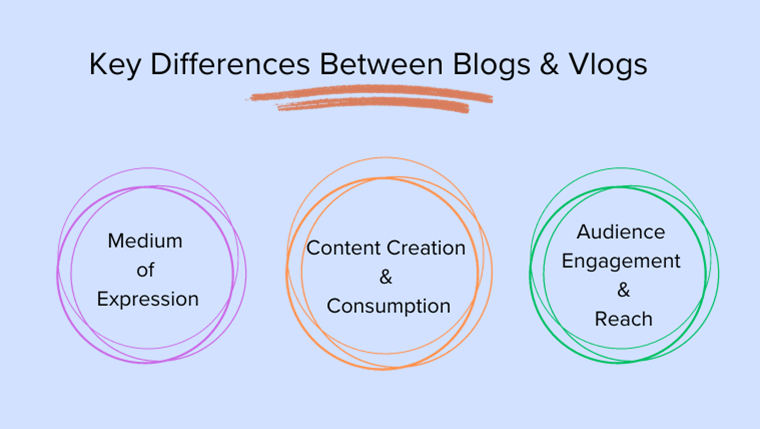
I) Medium of Expression
One of the most obvious differences between a blog and a vlog is the medium of expression.
Blogs use mainly text and images to communicate their message, while vlogs use mainly video and audio. This means that blogs and vlogs require different skills and styles to create and consume content.
Here’s a quick table to highlight the difference between a blog and a vlog in terms of medium of expression.
| Aspect | Blogs | Vlogs | Difference |
| Medium of Expression | Primarily text and images. | Mainly video and audio. | Blogs use text; Vlogs use video/audio, demanding distinct skills. |
| Text-based vs. Video-based | Text-based content that can include multimedia. | Video-based content with supplementary formats. | Different content formats, tailored for reading or watching. |
| Writing styles vs. Presentation styles | Various writing styles such as informative, persuasive, narrative, etc. | Various presentation styles such as talking head, review, journey, etc. | Different approaches to convey information, written vs. visual. |
II) Content Creation and Consumption
Another difference between a blog and a vlog is the content creation and consumption process.
Content creation refers to the time and effort required to produce the content. Meanwhile, content consumption refers to the preferences and behavior of the audience when accessing the content.
So, here’s a quick table to highlight the differences in content creation and consumption between a blog and a vlog.
| Aspect | Blogs | Vlogs | Difference |
| Time Required for Creation | Generally less time and effort. | Tends to take more time and effort. | Vlogs involve scripting, filming, editing, and uploading steps. |
| Researching/Writing vs. Scripting/Filming | Involves researching, writing, editing, and publishing. | Involves scripting, filming, editing, and uploading. | Varied processes and skills in content creation for each medium. |
| Consumption Preferences of Audiences | |||
| How | Larger screens and keyboards. | Smaller screens and speakers. | Different devices are suitable for reading blogs or watching vlogs. |
| When | Work hours or leisure time. | Normal hours or downtime. | Different times of the day for accessing each medium. |
| Where | Quiet & comfortable environments. | Any environment whether quiet or noisy. | Varied environmental preferences for consuming each medium |
| Why | Learning and inspiration. | Entertainment and connection. | Different motivations for accessing content in each medium. |
III) Audience Engagement and Reach
Last but not least, the difference between a blog and a vlog is the audience engagement and reach.
Audience engagement refers to the level and quality of interaction between the content creator and the audience. Meanwhile, audience reach refers to the size and diversity of the audience that the content can attract and retain.
So, here’s again another table to highlight the difference between a blog and a vlog on this ground.
| Aspect | Blogs | Vlogs | Difference |
| Engagement Metrics | |||
| Pageviews | Number of times a blog post or page is viewed. | Number of times a vlog post or video is viewed. | Metrics differ based on the format and platform. |
| Time on Page/Watch Time | Amount of time the audience spends on a blog post/page. | Amount of time the audience watches a vlog post/video. | Different metrics, measuring engagement duration. |
| Bounce Rate/Retention Rate | Percentage of the audience leaving after one view. | Percentage of the audience watching until the end. | Indicators of content stickiness, vary for each medium. |
| Demographic Differences in Audience Preferences | |||
| Age | Older audiences (millennials, Gen X) | Younger audiences (Gen Z, Gen Alpha) | Difference in the preferred medium by age group. |
| Education | Appeals more to educated audiences. | Appeals more to less educated audiences. | Educational background influencing content preference. |
With that, you’ve now learned the key differences between a blog and a vlog on several grounds. Let’s jump into the next portion to explore its similarities.
F) Similarities Between Blogs and Vlogs
Yes, blogs and vlogs are different in many ways. But they also have some similarities that make them appealing and effective forms of online content creation.
Thus, the similarities between these 2 are highlighted in the following domains:
I) Storytelling and Content Creation
One of the similarities between blogs and vlogs is that they both involve storytelling and content creation.
Storytelling and content creation refer to the process of crafting and sharing a narrative or a message on a topic. That is relevant, valuable, and engaging to the audience.
So, whether you’re blogging or vlogging, the storytelling and content creation phase follow similar steps. Such as:
Step i: Choosing a topic you’re passionate about and your audience loves.
Step ii: Researching the topic, keywords, and reliable sources for quality content.
Step iii: Planning your content with an outline, script, or storyboard based on the format.
Step iv: Producing your content by writing, filming, editing, and publishing.
Step v: Promoting your content through sharing, distribution, and marketing on platforms like social media, email, or SEO.
Meanwhile, storytelling and content creation for blogs and vlogs can also have similar goals. Such as:
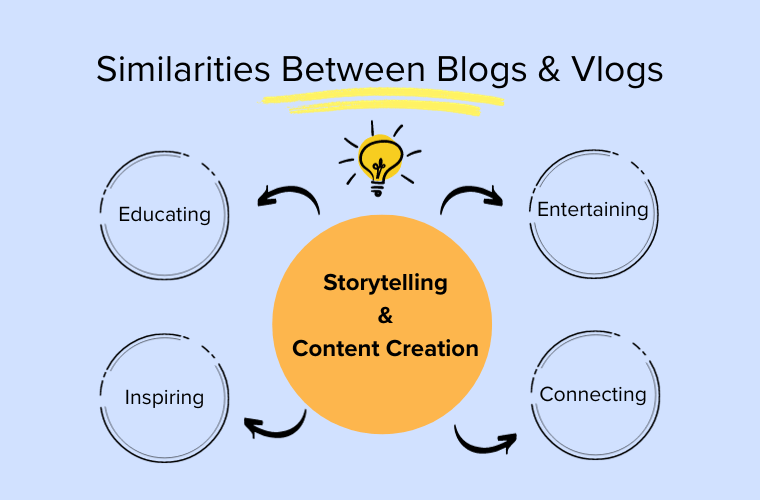
- Educating the audience on a topic that they want to learn more about or that they need to solve a problem.
- Entertaining the audience on a topic that they enjoy or that they find amusing.
- Inspiring the audience on a topic that they aspire to or that they find motivating or uplifting.
- Connecting with the audience on a topic that they relate to or that they find personal, emotional, or relatable.
II) Monetization Opportunities
Likewise, another ground for a similarity check between a blog and a vlog is that they both offer monetization opportunities.
Monetization opportunities refer to the ways that content creators can earn money from their content, either directly or indirectly.
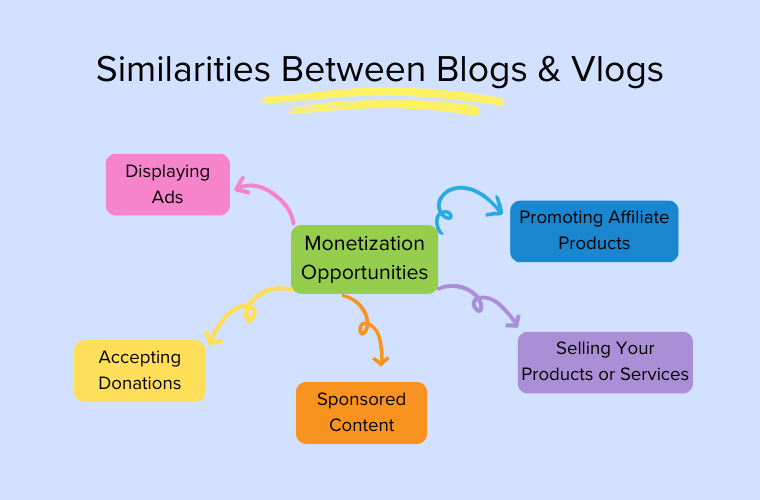
As we’ve discussed earlier in the understanding portion, both provide similar opportunities. Such as:
- Displaying Ads: Place ads in your content through platforms like Google AdSense or direct advertisers, earning income based on views or clicks.
- Promoting Affiliate Products: Share affiliate products through links, banners, or reviews, earning a commission for each sale or action.
- Selling Your Products or Services: Offer your products or services in the content, like ebooks or courses. And earn based on audience purchases or subscriptions.
- Sponsored Content: Feature sponsored posts or reviews relevant to your niche. So, you can earn bucks based on views or conversions.
- Accepting Donations: Enable audience support via platforms like PayPal, or by creating a membership site or paywall. So, you can earn money based on the number of supporters or members.
Now that you’ve learned the key differences and similarities, let’s dive in to choose between a blog and a vlog.
G) Choosing Between Blogging and Vlogging
No doubt, blogging, and vlogging are great ways to create and share content online, but they also have their pros and cons.
Hence, depending on your goals, skills, preferences, and resources, you may find one more suitable than the other.
In this section, let’s explore the factors to consider when choosing between blogging and vlogging. Or, how can you combine them for optimal results?
I) What Factor to Consider?
Choosing between blogging and vlogging is not an easy decision, as there are many factors to consider. Here are some of the most important ones:
i) Your Personality & Style
Do you enjoy writing or speaking more? Are you comfortable on camera or do you prefer to stay behind the scenes? Do you have a unique voice or a captivating appearance?
Your personality and style can influence how you express yourself and how you connect with your audience.
ii) Your Niche and Topic
What is your niche and what topics do you want to cover? Some niches and topics are more suitable for blogs, while others are more suitable for vlogs.
For example, if you want to teach something complex or technical, a blog may be more effective. If you want to show something visual or entertaining, a vlog may be more appealing.
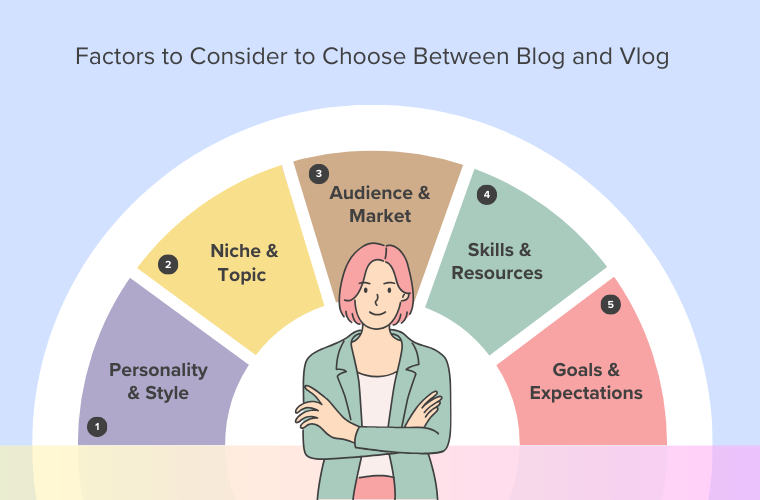
iii) Your Audience and Market:
Who is your target audience and what are their needs, preferences, and behaviors? Some audiences may prefer to read blogs, while others may prefer to watch vlogs.
For example, if your audience is older and educated, they may be more likely to read blogs. If your audience is younger and less educated, they may be more likely to watch vlogs.
iv) Your Skills and Resources:
What skills and resources do you have or need to create blogs or vlogs? Blogs and vlogs require different skills and resources. Such as writing, editing, SEO, filming, lighting, etc.
For example, if you have good writing skills, SEO knowledge, and web design skills, then you may find blogging easier. Meanwhile, if you have good presentation skills, video editing skills, and camera equipment, then you may find vlogging easier.
v) Your Goals and Expectations:
What are your goals and expectations for your content creation? Blogs and vlogs have different goals and expectations, such as traffic, engagement, monetization, etc.
For example, if your goal is to generate traffic, then blogs may be more effective, as they can rank higher on search engines. Meanwhile, if your goal is to generate engagement, vlogs may be more effective, as they can evoke more emotions and reactions.
Once you’ve answered these aspects, we believe you can easily choose between a blog and a vlog.
II) Combining Blogging and Vlogging
Yet, are you still undecided between blogging and vlogging? What if we tell you that you can also combine both blogging and vlogging to maximize your content creation potential?
No doubt, combining blogging and vlogging can have many benefits. Such as reaching a wider and more diverse audience, increasing your authority and credibility, diversifying your income streams, and more.
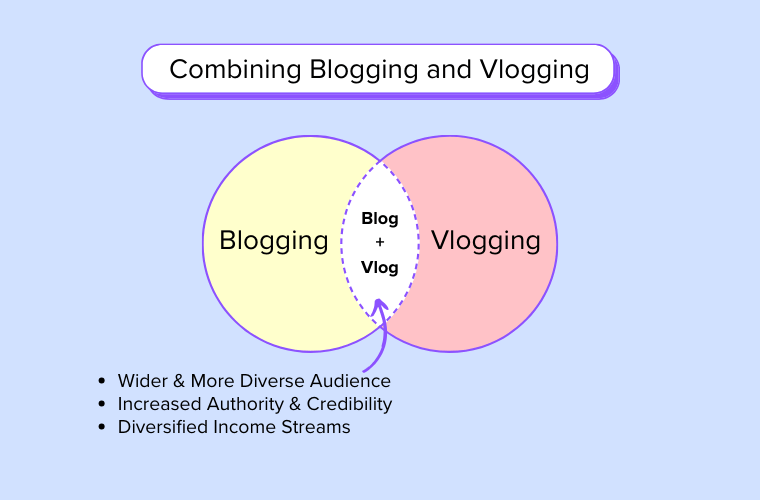
However, combining blogging and vlogging also has some challenges. Like spending more time and effort, balancing your content strategy, and maintaining your consistency.
So, how do you combine blogging and vlogging effectively? Well, you can always choose a platform that supports both blogs and vlogs, such as WordPress or YouTube.
WordPress is a popular CMS (Content Management System), used by most bloggers to create and manage the website. You can publish your blog posts and embed your vlogs.
Meanwhile, YouTube is a popular vlogging platform that allows you to upload and share your videos. You can also add descriptions, links, and tags to your vlogs. What’s more, you can use both platforms together, by linking your WordPress site to your YouTube channel, or vice versa.
And the best part is you can always repurpose your content. Such as turning your blog posts into vlog scripts, or embedding your vlogs into your blog posts. This helps you save time and effort, reach new audiences, and reinforce your message.
So, what’re you waiting for? You’re all set to start your blogging and vlogging journey!
H) Future Trends and Evolutions of Blogs and Vlogs
Blogs and vlogs are constantly evolving and adapting to the changing needs and expectations of online content creators and consumers.
Whether you choose to blog, vlog, or both, you need to keep up with the emerging technologies and shifting audience preferences. That may affect your content creation and consumption.
Here, let’s explore some of the future trends and evolutions of blogs and vlogs in terms of the following grounds.
I) Emerging Technologies & Their Impact
Technologies are certainly changing how we make and watch vlogs. And we can all see the future is all about fancy tech stuff.
Today, there has been a significant rise in AR (Augmented Reality) and VR (Virtual Reality). Consequently, this helps you create and enjoy more realistic and interactive stories. AR and VR can make vlogs more fun and exciting for the audience.

Similarly, blogs are also affected by emerging technologies like AI (Artificial Intelligence). This can help bloggers write faster and better. Ultimately, creating content that is high-quality, data-driven, and personalized.
II) Shifting Audience Preferences & Consumption Patterns
Similarly, as audience preferences continually evolve, there is a significant rise in short-form video content. Particularly, platforms like TikTok and Instagram Reels are reshaping how information is consumed.
Therefore, whether you’re a blogger or a vlogger, you’ll need to adapt to the demand for concise and visually appealing content to stay relevant.

At the same time, long-form and short-form content are becoming more similar. Blogs and vlogs have to be more versatile and offer different content lengths to suit different audience needs. This versatility will be important for keeping the audience engaged.
With that, this brings us to one common ground. That is you must stay in sync with tech and audience trends for the future success of both blogs and vlogs. Also, don’t forget to be consistent, creative, and valuable in your content creation and delivery.
I) Frequently Asked Questions (FAQs) on the Difference Between a Blog and a Vlog
Now, we’ll answer some of the most FAQs on the difference between a blog and a blog to clear your pathway.
Q.1 What is the fundamental difference between a blog and a vlog?
A: Blogs primarily use text and images, while vlogs rely on video and audio content.
Q.2 How do blogs and vlogs impact audience engagement differently?
A: Blogs engage through written content, comments, and shares, while vlogs use visual and auditory elements, likes, and subscribers for engagement.
Q.3 Can one person manage both a blog and a vlog simultaneously?
A: Yes, many content creators successfully combine both mediums, offering a multimedia approach to their audience.
Q.4 Which skills are essential for starting a blog? How about starting a vlog?
A: Blogging requires writing, SEO, and content formatting skills, while vlogging demands video creation, editing, and presentation skills.
Q.5 Are blogs and vlogs equally profitable, and how can creators monetize them?
A: Both can be profitable. Blogs monetize through ads, affiliates, and product sales, while vlogs use ads, sponsorships, and product placements.
Q.6 Can blogs incorporate videos, and can vlogs include written content?
A: Yes, blogs can embed videos for richer content, and vlogs can include written elements like captions or accompanying blog posts.
Q.7 How do emerging technologies, like AR and AI, impact the future of both blogs and vlogs?
A: AR and VR enhance vlog experiences, while AI streamlines content creation for blogs, shaping the future of both mediums.
Conclusion
And that’s all, folks! We hope this article has helped you understand the difference between a blog and a vlog.
In a nutshell, blogs and vlogs are both popular and effective forms of online content creation and consumption. They have some similarities along with simultaneous differences.
Depending on your goals, skills, preferences, and resources, you may find one more suitable than the other. However, you can also consider combining both forms of content creation, as they can complement and enhance each other.
If you have any questions or feedback, then please let us know. We would love to hear from you.
Check our article on how to make a website if you’re planning to build one using WordPress. Also, browse other reads such as the best blog grid plugins and best video player plugins.
Follow us on our social media handles Facebook and Twitter to stay in touch with our content.
